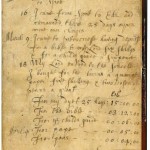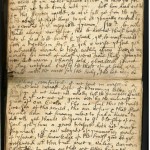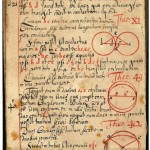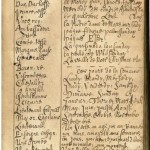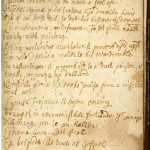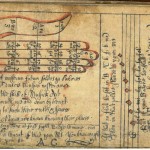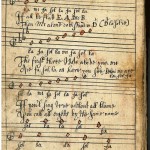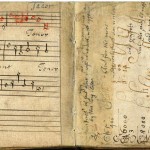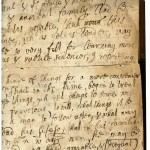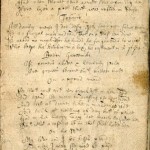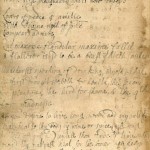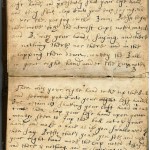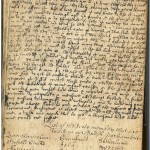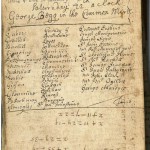There is a mystery surrounding this small volume, deposited with the Council Archives as part of the collection of records from Dunblane Cathedral. It is not at all clear who owned the book nor why it ended up in Dunblane.
The volume contains notes on all kind of subjects and has clearly been the notebook or commonplace book of a schoolmaster. It would appear that the book originally belonged to an English schoolteacher as it begins with a series of accounts including the cost of travelling from Ayton in Berwickshire to Spott in East Lothian and then on to Pittencrieff near Dunfermline: –
“8 Feb. 1687 I took my leave of Aytoune & came to Spott.
16 Feb. 1687 I came from Spott to Ed[inbu]r and remained there 25 days
9 Mar. 1687 I came to Pittencrieff being Wensday
17 Mar. 1687 Went to the Schoole of dumfermling”
There are names written in the volume, notably Archibald Colme, John Colme and John Young. One page near the centre of the volume has the inscription ‘Alexander Moir now his book’.
None of these men are known to have been the Parish Schoolmaster for Dunblane according to its historian, Alexander Barty who devotes a chapter to the schoolmasters of the parish in his book ‘The History of Dunblane’. The schoolmasters for Dunblane Parish School at this time were a Duncan Niven from the 1650s to 1694 when he was succeeded by a Mr McEchnie who was also Precentor and Clerk to the Kirk Session. McEchnie was succeeded around 1700 by Mr McGown who remained in post until 1743.
It is possible that the book with its wealth of information was passed on to one of the men mentioned above by an owner and then kept for reference. Certainly it was owned by more than one person as the handwriting within it varies considerably.
The book is a fascinating insight into education in the late 17th century and has many notes for use in the classroom. These include details of weights and measures, notes on arithmetic and geometry, French and latin phrases, grammar and vocabulary and musical notation along with the music for some commonly used psalm tunes from the period.
Whole lectures are written out for the edification of pupils including an essay on living a virtuous life and sermons based on biblical texts.
Along with the educational material, there are all kinds of songs, poems, jokes and doodles. There is a list of the schoolmaster’s library: ‘at Ayton the 20th of December 1697 I digested my books into five shelves…’ The writer notes the following on the subject of alcohol ‘the first draught serveth for health, the second for pleasure, the third for shame & the 4th for madness…’ There are three pages devoted to a detailed explanation of how to perform the three balls under three cups routine so frequently used by gamblers.
Also included is a list of the ‘Scots members that are To sitt in our British Parliament’. This refers to the first Parliament elected after the Act of Union in 1707. The small volume is packed with wonderful items and would repay detailed study.
